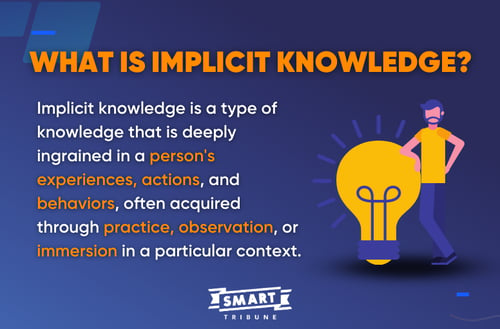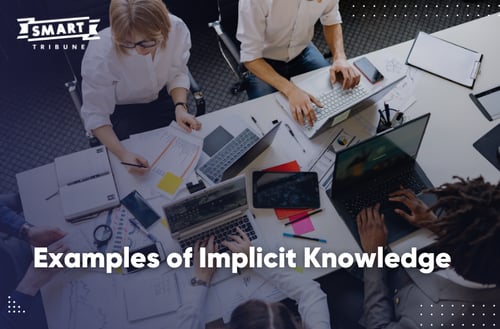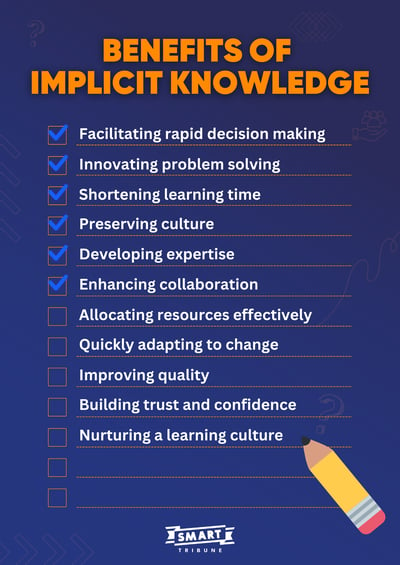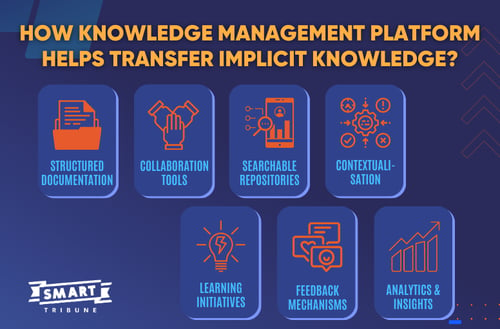In the realm of knowledge, not all that we know is easily expressible in words or consciously accessible. Implicit knowledge, which is an elusive form of knowledge plays a significant role in shaping our actions, decisions, and interactions in the workplace. In this comprehensive article, we delve into the depths of implicit knowledge to explore:
- Implicit knowledge definition,
- Examples,
- Benefits implicit knowledge,
- Comparison of implicit vs. explicit vs. tacit knowledge,
- Guide to transferring implicit knowledge,
- Frequently asked questions about implicit knowledge in the workplace.
Let's get cracking!
.webp?width=500&height=330&name=What%20is%20Implicit%20Knowledge%20(1).webp)
What is Implicit Knowledge?
Implicit knowledge in the workplace refers to the knowledge, skills, understanding, and insights that employees possess but may not necessarily be explicitly documented or articulated. It's the type of knowledge that individuals have acquired through experience, observation, interactions, and practice over time. 
This knowledge is often deeply ingrained and can be difficult to convey or transfer to others, making it a valuable but potentially overlooked aspect of organizational effectiveness.
Related insight: What Is Knowledge Management?
Examples of Implicit Knowledge in the Workplace
Though implicit knowledge is present around you and your workplace, you may not recognize it. Let's check out five typical implicit knowledge examples in different professional settings: 
- Sales negotiation skills: Seasoned sales professionals possess implicit knowledge about how to navigate negotiations effectively. They can read client cues, gauge their needs, and adjust their approach intuitively to close deals.
- IT troubleshooting expertise: IT specialists often rely on implicit knowledge to diagnose and resolve complex technical issues. Their deep understanding of systems, coupled with years of experience, enables them to identify solutions at short notice.
- Project management intuition: Experienced project managers possess implicit knowledge about managing teams, timelines, and resources. They can anticipate potential challenges and take preemptive actions to keep projects on track.
- Effective customer service: Customer service representatives develop implicit knowledge in understanding customer emotions, needs, and expectations. This allows them to provide personalized assistance, defuse challenging situations or deal with angry customers with ease.
- Leadership decision-making: Leaders draw upon implicit knowledge to make informed decisions that align with their organization's values and goals. This includes considering the broader impact of their choices on team morale and organizational culture.
These examples highlight how implicit knowledge enhances efficiency, effectiveness, and collaboration within the workplace, contributing to better outcomes and a thriving organizational environment.
Check out:
Benefits of Implicit Knowledge
Although challenging to precisely measure, the advantages stemming from implicit knowledge in the workplace can notably influence every member of a company. Let's zoom in on its merits. 
- Facilitating rapid decision making: Implicit knowledge often derives from years of experience and exposure. Employees with implicit knowledge can make informed decisions quickly and effectively, drawing upon their intuition and accumulated insights.
- Innovating problem solving: Implicit knowledge allows employees to approach problems from unconventional angles, leading to innovative solutions. This creative thinking stems from the combination of past experiences and intuitive leaps.
- Shortening learning time: New employees can benefit from the implicit knowledge of their more experienced colleagues. By learning from those who have "been there, done that," newcomers can avoid common pitfalls and accelerate their learning curve.
- Preserving culture: Implicit knowledge often carries cultural practices, unwritten rules, and shared values within an organization. This contributes to maintaining the organization's unique identity and preserving its traditions.
- Developing expertise: Implicit knowledge evolves over time, transforming employees into experts in their respective fields. This expertise becomes an invaluable asset that can be leveraged for organizational growth.
- Enhancing collaboration: Implicit knowledge sharing encourages collaboration among team members. Employees are more likely to seek advice from those with valuable insights, fostering a culture of cooperation.
- Allocating resources effectively: Employees with implicit knowledge understand which resources are essential for a particular task which brings expense optimization and efficient allocation to the table.
- Quickly adapting to change: When faced with changes in processes, technologies, or market dynamics, employees with implicit knowledge can adapt more quickly due to their deep understanding of underlying principles.
- Improving quality: Implicit knowledge helps employees identify subtle nuances that contribute to the quality of products or services. This attention to detail leads to continuous improvement.
- Building trust and confidence: Employees who consistently demonstrate expertise through their actions build trust and confidence among colleagues, supervisors, and clients.
- Nurturing a learning culture: Embracing implicit knowledge fosters a culture of continuous learning and knowledge sharing within the organization, promoting professional growth.
Implicit Knowledge vs Tacit Knowledge vs Explicit Knowledge
Implicit Knowledge, Tacit Knowledge, and Explicit Knowledge are terms often used interchangeably, but they represent distinct forms of knowledge. Understanding their differences is crucial for effective knowledge management and communication. Let's delve into each concept.
|
Type |
Definition |
Characteristics |
Communicability |
|
Explicit knowledge |
Is formal, codified, and easily communicated in words, numbers, diagrams, or other tangible forms. |
- Easily articulated and communicated. - Can be formalized and documented. - Can be easily shared and distributed. - Transmittable through training or written materials. |
easily communicable, formally documented, and structured. |
|
Tacit knowledge |
Is often referred to as "know-how" and resides within an individual's mind |
- Difficult to express in words or formal documents. - Gained through personal experience and intuition. - Influences behavior, judgment, and actions. - Often shared through interactions, mentoring, or collaboration. |
unarticulated, personal, and rooted in experience, intuition, and context. |
|
Implicit knowledge |
is closely related to tacit knowledge and often used interchangeably, but it emphasizes the idea of knowledge that influences actions without conscious awareness. |
- Guides actions and decisions unconsciously. - Difficult to express even compared to tacit knowledge. - Influences intuition, judgments, and behavior. - Often difficult to recognize or share due to its hidden nature. |
a subset of tacit knowledge that operates unconsciously and guides actions without conscious awareness. |
How to Transfer Implicit Knowledge?
Transferring implicit knowledge in the workplace is a critical endeavor to ensure that valuable insights, skills, and expertise are shared among team members and preserved for the organization's success. Here come steps to take to effectively transfer implicit knowledge.

Learn more:
- How to develop a knowledge management framework that benefits your business
- The basics of creating and managing a knowledge base
Preparation phase
Identify key implicit knowledge
Before you can transfer implicit knowledge, it's essential to identify what knowledge is crucial for the organization's success. The inspection will aid you in recognizing the skills, insights, and intuitions that team members possess but might not be explicitly documented.
Accelerate your preparation time with steps to develop a winning knowledge management strategy.
Encourage reflection and self-awareness
Decision-makers should encourage employees to reflect on their experiences, decisions, and the factors that influence their intuitive judgments. The reason is that this self-awareness helps them recognize their implicit knowledge and its origins.
Implementation phase
Pair up employees
Leaders can pair experienced employees with those who are less experienced to create an opportunity for the less experienced individuals to shadow their more experienced counterparts. Novices can learn by observing experts' actions, analyzing their decisions, and picking up problem-solving techniques.
Share story and anecdotes
Managers are in charge of encouraging team members to share stories and anecdotes that highlight situations where their implicit knowledge played a significant role. Stories humanize the knowledge transfer process and provide context for understanding complex situations.
Provide structured mentoring
Learning and development departments should consider implementing a mentoring program where experienced employees mentor newer ones. Structured mentoring sessions supply a platform for discussing specific scenarios, insights, and decision-making processes.
Document best practices
While implicit knowledge might be challenging to articulate, encouraging employees to document their best practices, even if it's in narrative form is a must. Over time, these documents can become valuable resources for the organization.
Take a shortcut to a comprehensive guide to knowledge transfer.
Encourage experimentation
Implicit knowledge often emerges from trial and error. That's why managers should encourage employees to experiment, take calculated risks, and learn from failures. This process helps develop intuition and expertise.
Hold regular knowledge-sharing sessions
Organizing regular knowledge-sharing sessions where employees can present their insights, experiences, and strategies to their colleagues substantially contributes to the promotion of a culture of sharing and learning.
Utilize technology
Organizations can leverage digital platforms, intranets, or collaboration tools to share implicit knowledge. It is highly recommended that you create a repository where employees can contribute their insights and experiences.
Smart Knowledge is a world-leading knowledge management platform that can support businesses to store prowess and understanding and encourage knowledge-sharing. Don't forget to book a demo to find out how Smart Knowledge helps boost efficiency.
Post-implementation phase
Recognize and reward knowledge sharing
Acknowledging and rewarding employees who actively participate in knowledge sharing initiatives will reinforce the importance of transferring implicit knowledge and foster a culture of collaboration.
Collect feedback
As knowledge is transferred, gathering feedback from both the knowledge sharer and the recipient is a must. This feedback loop allows for refinement and improvement of the knowledge transfer process.
How does A Knowledge Management Platform help Transfer Implicit Knowledge in Workplace?
A knowledge management platform, like Smart Knowledge facilitates the transfer of implicit knowledge at the workplace by providing structured mechanisms for capturing, organizing, and sharing this valuable expertise. Here's how:

- Structured documentation: Knowledge management platforms allow employees to document their implicit knowledge in a structured manner. This might include narratives, stories, or context-rich explanations that capture the underlying thought processes and experiences.
- Collaboration tools: These platforms offer collaborative spaces where employees can discuss, share, and refine their implicit knowledge. Team members can ask questions, provide feedback, and contribute their insights, fostering a culture of learning and knowledge exchange.
- Searchable repositories: Implicit knowledge can be cataloged and stored in searchable repositories, making it accessible to others in the organization. This enables employees to find relevant insights quickly when facing similar challenges.
- Contextualization: Knowledge management platforms enable contributors to provide context around their implicit knowledge, explaining the situations, factors, and nuances that influenced their decisions. This contextual information enhances understanding.
- Continuous learning initiatives: The platform can be integrated with continuous learning initiatives, offering courses or modules that focus on recognizing, transferring, and leveraging implicit knowledge effectively.
- Feedback mechanisms: Employees can provide feedback on the usefulness and relevance of shared implicit knowledge. This iterative process ensures that the knowledge remains accurate and valuable over time.
- Analytics and insights: Knowledge management platforms often provide analytics to track which pieces of implicit knowledge are most accessed or contributed to, helping organizations identify areas of expertise and interest.
In essence, a knowledge management platform transforms implicit knowledge from an intangible concept into a tangible and shareable resource. It bridges the gap between personal experiences and collective learning, fostering an environment where employees can tap into each other's expertise to drive innovation and growth.
Still curious about how a knowledge management platform does wonders for your business, schedule a personalised demo for further discovery.
FAQs about Implicit Knowledge
What is a knowledge base?
A knowledge base is a centralized repository of organized information, insights, and resources that serves as a reference for solving problems, making decisions, and sharing expertise.
What is knowledge management?
Knowledge management is the process of capturing, organizing, sharing, and leveraging an organization's collective knowledge to improve decision-making, problem-solving, and innovation.
Transfer Implicit Knowledge Effectively to Boost Productivity
Apparently, implicit knowledge stands as a powerful yet enigmatic force within the workplace. It guides decisions, enriches interactions, and fosters innovation. As we've explored its definition, learned from real-world examples, and grasped its manifold benefits, we've unveiled its unique role in contrast to explicit and tacit knowledge. Hope that through our guide to transferring this intangible wisdom, you can take strides toward harnessing its potential with a powerful knowledge management tool.
Should you have any questions regarding implicit knowledge or how to transfer this elusive wisdom, drop Smart Tribune a line for further assistance.


